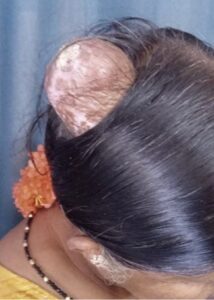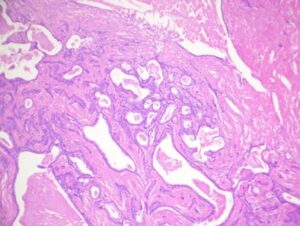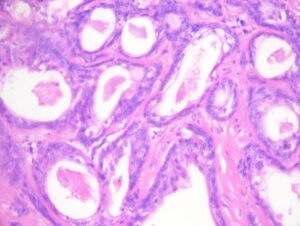Vinay HG1*, Naveen N1, Ramprashanth MP1
1Department of General Surgery, Vamshodaya Hospital, Kolar, Karnataka, India
*Correspondence author: Vinay HG, MS General Surgery, FSGE, Department of General Surgery, Vamshodaya Hospital, Kolar, Karnataka, India; Email: [email protected]
Published On: 18-06-2024
Copyright© 2024 by Vinay HG, et al. All rights reserved. This is an open access article distributed under the terms of the Creative Commons Attribution License, which permits unrestricted use, distribution and reproduction in any medium, provided the original author and source are credited.
Abstract
Background: Chondroid syringomas are rare benign mixed epithelial tumors of the skin which share similarities with pleomorphic adenomas of the parotid gland.
Clinical Description: Middle-aged female with swelling over the right parietal region of scalp for 5 years with a history of recurrence for 2 years.
Management: Ultrasonography and fine needle aspiration of the swelling was done. Excision under local anesthesia was carried out and the specimen was sent for histopathological analysis.
Conclusion: Histopathological diagnosis of excised tumors is crucial in planning further management for the patient and has to be made compulsorily in all cases.
Keywords: Mixed Tumors; Benign; Middle-aged; Female
Introduction
Chondroid syringoma is a benign and rare mixed epithelial tumor of the skin with an incidence of less than 0.01% to 0.098%. It was initially described by Billroth in 1859, as a “mixed tumor of the skin”. Similarities between the parotid’s pleomorphic adenoma and Chondroid syringoma exist due to its histological features. However, the term “Chondroid syringoma” was described by Hirsch and Helwig in 1961 [1]. The tumor diagnosis is often difficult and only confirmed after histological analysis. Here we represent one such tumor in a middle-aged lady. Our case is interesting because there was a history of tumor recurrence with cystic degeneration on histopathological analysis.
Clinical Description
A middle-aged woman presented with a swelling on the right side of the scalp for a long duration of 5 years, with progression in size. It was initially not associated with pain, however, with progression, a dull aching type of pain developed. She underwent an excision of the tumor 2 years back, however on enquiry she did not have any documents related to the previous excision. She did not have any complaints of fever or any history of local trauma. On examination, a globular swelling approximately 5cm by 4 cm over the right high parietal region of the scalp was noted. The skin over the swelling appeared stretched with a shallow ulcer on the summit. On palpating, no local rise of temperature or tenderness was present and the skin was not pinchable. The swelling was firm and mobile and not fixed to the underlying bone. Occipital lymph nodes were not palpable (Fig. 1). Excision was carried out under local anesthesia under complete aseptic precautions. The mass was removed in-toto and sent for histopathological examination. The analysis of the specimen revealed sections of the nodular mass showing grey white and yellow areas. On microscopic examination, a well-circumscribed tumor tissue composed of cells forming elongated branching tubular structures with 2 cell layers – outer cuboidal layer with an inner columnar layer. Focal areas showing sebaceous differentiation, mucinous metaplasia and clear cell change were also noted. However, there was no evidence of increased mitosis, nuclear atypia or necrosis (Fig. 2,3). Ultimately, the diagnosis of recurrent chondroid syringoma with cystic degeneration was made and patient was requested to follow-up.

Figure 1: Swelling over the right high parietal region.

Figure 2: 40x H&E Staining of the specimen.

Figure 3: 100x H&E Staining of tumour showing extensive cystic degeneration with dense lymphoid aggregates and lymphoid follicles.
Discussion
Chondroid syringomas are uncommon mixed epithelial tumors which can be eccrine or apocrine in origin. However, on analysis of the cellular strands and acini of the tumor, a dense blue-black reaction to the phosphorylase was seen. This supported the eccrine origin of the tumors and was confirmed by Winkelmann and Muller [2]. Two-thirds of the tumors occur in the region of the neck with the following decreasing order of frequency: nose, cheek, upper lip, scalp, forehead and chin. The size of the tumor is usually 0.5 to 3 cm and presents as an asymptomatic slow-growing swelling [3]. They are often misdiagnosed clinically as dermoid or sebaceous cysts, neurofibromas or salivary gland pleomorphic adenoma. The swelling is commonly excised and sent for histopathological examination. The following histological features are required for diagnosis [1]:
- Nests of cuboidal or polygonal cells
- Tubulo-alveolar structures lined by two or more rows of cuboidal cells
- Ductal structures composed of 1 or rows of cuboidal cells
- Occasional keratin cysts
- A matrix of varying appearance with Hematoxylin and Eosin staining
Malignancy is sometimes associated with the tumor where the clinical presentation is altered with increased mitotic figures and cytological atypia [4]. Metastatic spread is more common in females and on the extremities. It classically spreads to regional lymph nodes is present in 48% of the patients and to bones and visceral organs in 45% [5,6]. The recurrence of chondroid syringoma is not established in the literature, with some studies quoting it as a result of incomplete excision. The recurrence rate ranges from 2.4% to 10% with one study reporting a high percentage of 18 [7,8]. The treatment remains the same for recurrent tumors which are usually excised [7].
Conclusion
Benign tumors of head and neck are a common entity; however final diagnosis can only be made after histopathological analysis. Though excision is usually curative, emphasis on the microscopic analysis by pathologists is crucial in the prognosis of the patient.
Conflict of Interests
The authors have no conflict of interest to declare.
References
- Schulhof Z, Anastassov GE, Lumerman H, Mashadian D. Giant benign chondroid syringoma of the cheek: case report and review of the literature. J Oral and Maxillofacial Surg. 2007;65(9):1836-9.
- Winkelmann RK, Muller SA. Sweat gland tumors. I histochemical studies. Arch Dermatol. 1964;89:827-31.
- Stout AP, Gorman JG. Mixed tumors of the skin of the salivary gland type. Cancer. 1959;12(3):537-43.
- Yavuzer R, Başterzi Y, Sari A, Bir F, Sezer C. Chondroid syringoma: a diagnosis more frequent than expected. Dermatol Surg. 2003;29(2):179-81.
- Jordan DR, Nerad JA, Patrinely JR. Chondroid syringoma of the eyelid. Can J Ophthalmol. 1989;24(1):24-7.
- Barnett MD, Wallack MK, Zuretti A, Mesia L, Emery RS, Berson AM. Recurrent malignant chondroid syringoma of the foot: a case report and review of the literature. Am J Clin Oncol. 2000;23(3):227-32.
- Ceylan A, Celenk F, Poyraz A, Uslu S. Pleomorphic adenoma of the nasal columella. Pathol Res Pract. 2008;204(4):273-6.
- Hornick JL, Fletcher CDM. Myoepithelial tumors of soft tissue: a clinicopathologic and immunohistochemical study of 101 cases with evaluation of prognostic parameters. Am J Surg Pathol. 2003;27(9):1183-96.
Article Type
Case Report
Publication History
Received On: 24-05-2024
Accepted On: 10-06-2024
Published On: 18-06-2024
Copyright© 2024 by Vinay HG, et al. All rights reserved. This is an open access article distributed under the terms of the Creative Commons Attribution License, which permits unrestricted use, distribution, and reproduction in any medium, provided the original author and source are credited.
Citation: Vinay HG, et al. Chondroid Syringomas of Scalp in a Middle-Aged Female: A Case Report. J Surg Res Prac. 2024;5(2):1-3.

Figure 1: Swelling over the right high parietal region.

Figure 2: 40x H&E Staining of the specimen.

Figure 3: 100x H&E Staining of tumour showing extensive cystic degeneration with dense lymphoid aggregates and lymphoid follicles.


